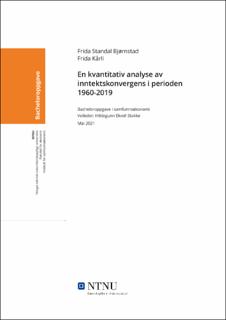En kvantitativ analyse av inntektskonvergens i perioden 1960-2019
Bachelor thesis

Permanent lenke
https://hdl.handle.net/11250/2777083Utgivelsesdato
2021Metadata
Vis full innførselSamlinger
Sammendrag
Formålet med oppgaven er å undersøke om det har vært tilfelle av inntektskonvergens i tidsperioden 1960-2019. Vi tar utgangspunkt i 90 land og tallene for BNP per innbygger (gitt i 2010 US$) og den gjennomsnittlige årlige vekstraten for disse landene. Videre knyttes dette opp mot Solow-modellen og Nelson-Phelps modellen som begge har som hensikt å forklare hvorfor internasjonale vekstrater er ulike.
Vi foretar en Barro-regresjon for utvalget vårt som en helhet og med regionale begrensninger. Disse begrensningene består av at vi ekskluderer først land i Afrika og deretter Asia og analyserer disse resultatene. Resultatet vi ser av analysene er at det ikke eksisterer en signifikant sammenheng mellom gjennomsnittlig årlig vekstrate og 1960-BNP per innbygger, det er først når vi legger inn regionale begrensninger at vi ser en sammenheng. The purpose of the thesis is to investigate whether there has been a case of income convergence in the period 1960-2019. We base the study on 90 countries and the numbers for GDP per capita (given in 2010 US$) and the average annual growth for these countries. Furthermore, we link this to the Solow model and the Nelson-Phelps model, both which are intended to explain why international growth rates are different.
We perform a Barro-regression with our sample, both as a whole and with regional restrictions. These restrictions consist of excluding countries in Africa, then Asia and analyzing these results. The result we see from the analyzes is that there is no significant correlation between the average annual growth rate and 1960 GDP per capita, it is only when we add regional restrictions that we see a correlation.